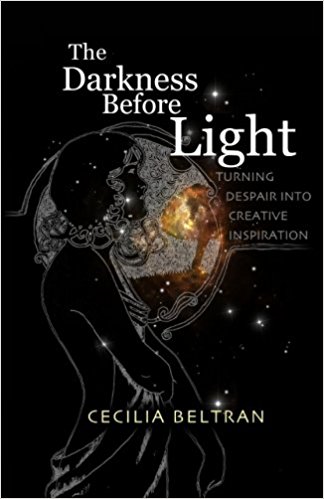The Goddess of the Star Card: Lighting the Way Back

Before diving into the symbolism of the Star card of the tarot, let’s first consider its predecessor the Tower, whose sudden onslaught of destruction will have already descended (precisely) like lightning upon us. By now, however, we have hopefully distanced ourselves from the drama enough to compartmentalize events in the gentler, more manageable abstractions of “dissolution” or simply of “loss.” Sometimes this act of distancing comes naturally with the passage of time, while at others it requires a conscious choice.
The element of conscious choice has a significant place in the present look into the symbolism of the Star card because it invites Logos into the mix. “Logic?” you ask. “Intellect and reason in the business of symbols?” Yes, because it’s the literalist—the dogmatist of symbolic hermeneutics who leans exclusively on the intuitive/associative/experiential encounter with the image—who believes the intellect has no part to play. For Logos is both complementary and necessary to an albeit predominantly intuitive, irrational process—and if the adjectives complementary and necessary are not ample, then let me add inescapable.
We’ll return to the Logos later, and to its correlation with choice, so please hold that thread. For now, however, having found ourselves here at ground zero, centered and empowered to consciously contribute as creators and cocreators to our own rebuilding, we are able to proceed with options of far greater scope and scale had the lightning not come in the first place. For such is the case with foundational work: the deeper we’ve gone—or should I say been sent?—the greater the potential if we choose to “build big.” So, on to the images of the Star card as our formative stage of renewal, and with a fuller appreciation of what they can teach us not about loss but rather about what we can do now that we’re back.
Read more
First we register the gestalt, the overall feel of the scene: distinctly serene, more at ease and in flow, and all in a deeply natural setting. Clearly it is nature’s harmonious aspect, her tending, nurturing side, not her destructive one. However at ease the scene may be, it is not idle, as demonstrated by the calm industriousness of the central actor and action of the card: the Woman. Her composed demeanor deepens the unembellished simplicity (and sincerity) of her nakedness. She is strong. And without need or concern for the egoic armor (symbolized by clothes) that we must don to defend ourselves from all the physical, social, and psychological dangers that accompany the human context. Vulnerable? Sure. But without urgency or fear. She instead possesses a quiet kind of confidence that seems to affirm all the more that she belongs here, her sensibilities and sensitivities exposed to a more immediate relationship with her environment and story—in short, with her myth.
I am tempted to say she is vulnerable to destiny. But not as a victim, not as acted upon as we see in the Tower, but rather by choice. Call it destiny in its dharmic sense, where one is simply on the Path, playing one’s part, doing precisely what it is one is called to do. One foot is placed on top of the water and not submerged in it as one would expect, emphasizing the conscious over the unconscious (for water is, among other things, an archetype of the unconscious). This highlights the conscious, rational attributes of choice and the capacity to act, both Logos based and intellect initiated.
On that note, I must insert an irrational criterion for relevant reasons to come—and because it’s just too valuable to omit: Hope—an irrational, emotional phenomenon quite beyond the domain of intellect. For the Star card is widely known as the card of hope, which is probably the single most potent initiator and ally to renewal. For sake of time, and rather than defining hope, to fully appreciate its value one needs only to consider its opposite: the ruinous destroyer despair (literally “de-hope”) and move on. So, hope. Sometimes descending by grace, but more often requiring us to open the door and get involved via conscious choice and action. In short, we must jump-start an attitude. Enter Logos. And please note that this simple act need not take more than a moment—less than even a second!—to perform its priceless function.
However brief, this intellectual maneuver is paramount, and not just with hope but with all kinds of content and contexts. Although it’s not my intention to get into the distinction between symbols and signs right now, I’ll share the following popular quote from Jung as an analogy, in lieu of an explanation, of what attitude can do: “Whether a thing is a symbol or not depends chiefly upon the attitude of the observing consciousness.” (The Collected Works of C.G. Jung, Psychological Types, 603) Point being, with attitude we can actually shift our conscious perspective, and in so doing we shift the whole (apparently) external environment, dimension, reality—whatever one wishes to call it—to reveal that which formerly lay hidden, embedded in the topography of our initial encounter. And this, as you’ve probably gathered by now, I find astounding.
With that point established to reinforce our focus on attitude’s relationship to what we can do, let’s return to the Woman, because for all this talk of being conscious and “above,” her business is quite “down.” She is kneeling down, looking down, pouring water down from jugs in her hands, all of which demonstrates a conscious perspective toward the unconscious, toward the foundational, with an attitude of tending—in other words, to “inner work.”
In this image one cannot help but think of Demeter, the Eleusinian Mysteries, and its theme of renewal, initiated first through Persephone’s abduction by Hades (surely a Tower event) and subsequently by Demeter’s fierce quest to retrieve her daughter from the underworld. She attends to the chthonic, the unconscious (cf., the jug that the Woman pours into water).
Third is Demeter’s archetypal role as grain goddess. And this is the conscious, the field of life symbolized by the other jug poured upon earth. Joseph Campbell speaks to both the conscious and unconscious sides of renewal while addressing the figures on the Terra Nouva Sarcophagus: “Demeter is seated on a sacred serpent-coiled basket, and from the mystic basket precedes the serpent, that which sheds its skin to be born again and which represents the engagement of life-giving consciousness in the field of time and space.” (Goddesses: Mysteries of the Feminine Divine, 195)
But we have further correlations to Demeter in the Woman’s bright golden hair. Straight from the poet’s mouth nearly three-thousand years ago:
… a lovely fragrance
from her perfumed veils
spread about
and a brightness from the immortal flesh
of the goddess
shone far away
and her blond hair
fell
to her shoulders
and the sturdy house
was filled with light
like lightning
(The Homeric Hymns, Charles Boer, Trans. 139)
Consider a moment all the brightness in the passage above. And next, how the Woman’s hair matches precisely (and only) the gold of the one larger star on the card. Is she then linked to a sun symbol, albeit shaped like a star? I’m fine with that. Or have we forgotten our sun is a star? Or so it is in the empirical fantasy. Since archetypal interpretation tells us sun is masculine, then we have an exception, which increases its emphasis via uniqueness. In short, there is something exceptional to the Woman’s sun connection, less as an ultimate symbol of Source or Being but rather more worldly in the Demeter sense—as in that which shines down and causes the flora and grain to grow—from germ to flower, from darkness to star.
 Yours,
Craig Deininger
Yours,
Craig Deininger
Weekly Quote
The absolute hangs like the moon above the water, and the water is my very own soul. Winds of desire stir my soul and my vision of the absolute. My reflection of the moon, my notion of eternity is in splinters, but I desire only to see the truth, to reflect the moon, and the winds die slowly …
Featured Video
Myth Resources
The Darkness Before Light
 The book is about the relationship of despair and creative inspiration. It resonates with the insights of James Hillman and Joseph Campbell, offering a way to turn despair into a self-illumination that can prove the source of powerful creative insights. It explores the lives of famous luminaries known to have suffered from despair and how their genius seemed to have emerged from their suffering.
The book is about the relationship of despair and creative inspiration. It resonates with the insights of James Hillman and Joseph Campbell, offering a way to turn despair into a self-illumination that can prove the source of powerful creative insights. It explores the lives of famous luminaries known to have suffered from despair and how their genius seemed to have emerged from their suffering.
Featured Work
Goddesses
Joseph Campbell brought mythology to a mass audience. His bestselling books, including The Power of Myth and The Hero with a Thousand Faces, are the rare blockbusters that are also scholarly classics. While Campbell’s work reached wide and deep as he covered the world’s great mythological traditions, he never wrote a book on goddesses in world mythology. He did, however, have much to say on the subject. Between 1972 and 1986 he gave over twenty lectures and workshops on goddesses, exploring the figures, functions, symbols, and themes of the feminine divine, following them through their transformations across cultures and epochs.
Editor Safron Rossi, a goddess studies scholar and professor of mythology, collected these lectures to create Goddesses. In this evocative volume, Campbell traces the evolution of the feminine divine from one Great Goddess to many, from Neolithic Old Europe to the Renaissance. He sheds new light on classical motifs and reveals how the feminine divine symbolizes the archetypal energies of transformation, initiation, and inspiration.
Subscribe to JCF’s email list to receive a weekly MythBlast newsletter along with occasional news and special offers from JCF.





